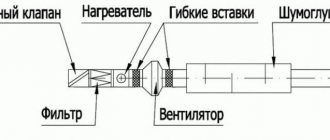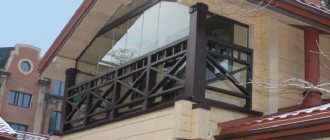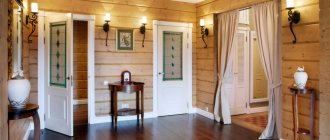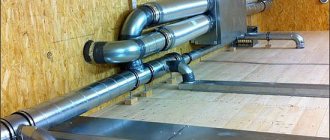On websites dedicated to construction, we can read that in a wooden house the walls “breathe”. However, this is not entirely true: the tree “inhales” not air, but excess moisture. Therefore, it will not be possible to ventilate all rooms using beams. The solution is to equip the building with a ventilation system.
Someone will think that the throughput of wood is enough to ventilate a house: they say, our ancestors lived in wooden huts and did not build any ventilation systems. But construction then and now are two big differences. No one monitored the airtightness of the peasant houses - the wind penetrated into the premises from all the cracks.
Now builders prevent drafts and heat loss. Firstly, they equip the walls with hydro, steam and thermal insulation. Secondly, wooden houses are often built from laminated veneer lumber, which does not allow air to pass through due to layers of glue. Thirdly, the cracks between the beams are sealed with sealant, and the wood is treated with varnishes and impregnations. As a result, the building is like a thermos - without ventilation it is hot, stuffy and uncomfortable.
Without ventilation, not only the residents, but also the tree itself experiences discomfort. Depending on air humidity, wooden structures dry out and crack over time, or, conversely, absorb moisture and swell. Fungus and mold appear on the walls; the tree rots and collapses. Good ventilation will help maintain optimal humidity levels.
Content:
- How ventilation works
- Attic ventilation
- Natural air exchange
- Exhaust ventilation type
- Roof of a wooden house and ventilation features
- Air exchange in the bathroom
- Ventilation of a wooden house toilet
- Ventilation of the floor of a wooden house
- Walls of a wooden house and metabolic processes
- Modern house: ventilation scheme
- Natural ventilation: positive and negative sides
- Air exchange in the house
- Ventilation system: stages of creation
- Supply system: installation features
- Supply and exhaust air exchange system
- Video on ventilation in a wooden house
A wooden house in itself is already a dream. Its owners live in an environmentally flawless home. To make life even better, you need to take care of proper ventilation of all rooms in the house. A wooden house feels moisture more than a stone one. Ventilation in a wooden house is an important factor in the health of the people living in it and the durability of the structure. There are factors that contribute to the destruction of wood without proper ventilation:
- fungus;
- mold;
- humidity.
The hackneyed saying “wood breathes” should not be taken into account when deciding on the installation of a hood in a wooden house.
How to install an air duct?
Most often, 2 air ducts are used to organize a supply and exhaust ventilation system. To make the circulation of air masses more uniform, take pipes of the same diameter. To speed up air removal, you can install an exhaust pipe with a slightly larger cross-section.
Install the air ducts at the greatest possible distance from each other on opposite walls. Along the route of the pipes, it is necessary to minimize the number of bends.
The exhaust pipe is mounted in one of the corners and its lower end should be near the ceiling so that all the warm air going up is removed through it. The air duct can be combined with a kitchen exhaust ventilation system and brought to the roof one and a half meters above the ridge.
The street air duct must be insulated, we wrote about this above. The most aesthetic option is to put another pipe on the pipe, but of a larger size, and lay any insulation in the resulting space. It is better to install a special ventilation deflector on the head of the pipe, which helps to increase traction.
The supply air duct is mounted in the opposite corner of the subfloor, and its open end should be as close to the ground as possible. The supply opening must be lower than the exhaust opening. In the same way, a pipe can be run through a house.
If the supply air duct is ducted through the roof, its intake opening should be located below the exhaust pipe. The outer edge of the draft pipe is raised on the roof to 20-25 cm.
Also, the supply pipe can be installed near the wall of the house outside. In this case, the hole should ideally be raised above the ground by 80cm. Inside, dampers are installed in each air duct to regulate the intensity of air movement.
The following article will introduce you to the rules for installing a ventilation system in the attic of a private house, covering in detail the principles of the device and the nuances of the structure.
How ventilation works
The air in a wooden house is special, but not because wood ventilates it, but because the material is natural and releases trace elements that create a natural smell. Wood can only absorb or release moisture. The microclimate is maintained only by the ventilation system.
The ventilation device in its classic form involves its placement in the attic. The riser, floors, ceiling are the location of hidden air routes (air is supplied and taken in through them). Distribution boxes are responsible for supplying and removing air. The inside is lined with a material that insulates noise.
The ventilation unit itself has a removable panel for easy filter replacement. Silencers are installed near it. A passage is made in the load-bearing wall to install the outlet. Its tasks include taking air from the street for further supply to the premises of the house.
Silencers are connected to the ventilation unit. A passage is made in the roof and a fungus is installed with a pipe connected to it, which removes air from the installation. Air ducts (corrugated plastic pipes) are connected to the ceiling boxes. The flexible air duct is connected to the air intake and air outlet sockets. Valves and ventilation grilles are installed on the outside of the walls and commissioning work is carried out.
Should you close the vents for the winter or not?
There are two points of view on whether to close the ventilation holes in the underground for the winter or not. If they are left open, moisture will not accumulate. And this is good, but in return we get a cold floor and increased heating costs. The solution is enhanced floor insulation so that ventilation does not affect its temperature and does not require increased heating.
If the vents are closed for the winter, moisture accumulates in the soil. Warm, moist air from the house enters the floor, falling on cold surfaces, and in winter these are the walls of the basement, the moisture condenses and flows into the ground. This means that later, in the summer, it will evaporate from there, increasing the humidity in the basement.
Attic ventilation
Ventilation in a wooden house with an attic floor has its own characteristics. An attic is a residential attic space that is located above the main living spaces. Properly installed ventilation prevents the harmful effects of condensation on the roof structure. Proper air exchange in the attic prevents overheating of the attic in the summer and the formation of ice in the winter (and as a result, corrosion of the metal elements of the roof, wetting of the insulation, the appearance of moisture and mold).
Additional humidity reduction
To ensure that the ventilation system does not have to be strengthened by increasing the total cross-section or installing fans, the following work must be carried out:
- Installation of an effective drainage system - removal of water from the foundation.
- Waterproofing the base of the house and the basement. There are many types of waterproofing: it can be rolled, built-up, coated, etc.
- Performing insulation. The best material in terms of economy and efficiency is EPS. This is a good heat insulator that does not allow water to pass through. It is not of interest to rodents and does not rot. EPS can also insulate the blind area.
The listed measures do not cancel, but simply supplement ventilation. Only in combination can you achieve ideal drainage of the space in the basement compartments.
If the house is built on a soil foundation that does not drain water well, in addition to the ventilation system, drainage and storm drainage are required. The drainage system will collect water from the soil and upper layers of soil, the storm drain will collect and drain precipitation
When installing a system according to a forced scheme, the costs for installation, maintenance and service will be higher than when organizing a natural type. It should be taken into account that in winter condensation can form on the walls of the ventilation pipes themselves, and in cold weather the cross-section can become completely clogged.
To avoid this, pipes can be thermally insulated with penofol. At the bottom turn of the pipe, you can come up with a condensate collector - for example, drill a hole or install a tee instead of an angle.
Natural air exchange
Do-it-yourself hood in a wooden house is a labor-intensive process and requires certain knowledge. There are several types of ventilation. One of them is natural. Air is supposed to enter the home through cracks in window and door systems. For effective air outflow, care should be taken to ensure that the outflow tract is taken care of. For this purpose, air ducts are installed. Modern construction technologies greatly complicate the process of natural air entering the room. To create conditions for free circulation of air flows in the rooms of the house, holes are made in the door leaf (decorated with grilles). Strong exhaust is ensured by the large length of the air duct.
Materials for the system design
For the arrangement of supply and exhaust ventilation air ducts, 3 types of pipes are used:
- Asbestos-cement ones are durable, resistant to corrosion and withstand frost well. They are of sufficient length, so during installation you can do without connections;
- Galvanized steel - resistant to corrosion, easy to install, and light weight. However, the price for metal components of ventilation systems is usually higher than for plastic and asbestos-cement ones;
- Plastic ones have a smooth inner surface, which ensures easy and fast air flow. Plastic pipes do not rust, they do not need to be cleaned, and their service life exceeds a couple of decades. One of their drawbacks is flammability.
The determining factor in the effectiveness of the ventilation system is the proportionality of the cross-section of the installed air duct to the area of the room in which it is installed. Heating engineers recommend adhering to the following norm when making calculations: 26 cm2 of section is required for 1 m2 of subfloor.
The most practical option for laying the exhaust part of the ventilation system in the cellar is an assembly made of polymer pipes. In addition to the affordable price, the opportunity to build a pipeline with your own hands is also attractive.
There is the following formula for calculating the required pipe diameter:
(S cellar × 26) ÷ 13.
That is, if the underground area is 9 m2, then a pipe with a diameter of 18 cm will be required: (9 × 26) = 208 ÷ 13 = 18 cm. For single-pipe ventilation, the diameter should be even larger, for example, 20 cm.
Exhaust ventilation type
The positive answer to the question of whether ventilation is needed in a wooden house is based on many years of experience in the construction and operation of private households. The organization of air flow is the basis of the principles of exhaust ventilation. Air intake must be ensured unobstructed. Natural supply ventilation supplies the house with air from the street. Main advantages:
- efficiency;
- simplicity of the ventilation system design;
- availability.
Exhaust ventilation in a private wooden house is provided for at the design stage. It is a central main line with branches that are designed to ensure the outflow of air from all rooms of the house. To increase operating efficiency, exhaust ventilation is equipped with fans mounted at the entrances of the ventilation ducts. The power of fans varies, so it is selected based on the volume of the room. The fans are economical; there are models with automatic operating modes.
Installing a window inlet valve
Window valves are mounted on the sash; it is quite easy to install this type of supply ventilation yourself in a private house. You will need the following tool:
- screwdriver;
- sharp knife;
- ruler no shorter than 35 cm.
window valve installation procedure
Work progress:
- We cut out the standard seal from the fixed frame in the place where the valve is intended to be installed.
- We install the seal that comes with the valve.
- We mark the location of the valve on the flap; it should coincide with the replaced area.
- We remove the seal section on the flap as well.
- We install valve plugs into the resulting gap. They must fit entirely into the slot so that the valve can subsequently be attached to them.
- The valve is glued to the double-sided tape and secured to the fasteners with self-tapping screws.
- A seal is inserted between the fasteners.
Now you can check the valve in action. The window inlet valve has several advantages:
- easy to install;
- during installation, all enclosing structures remain intact and intact;
- you can regulate the intensity of the inflow or completely block it.
And there is only one drawback: in severe frosts it can freeze. But there are branded models that do not have this drawback. You will have to pay more for them.
Another model of window valve is the handle valve. A very convenient device, the installation of which will have to be entrusted to a specialist.
Roof of a wooden house and ventilation features
One of the main problems that arise when operating a house is the so-called “dew point”. Natural cooling of the air heated in the house leads to condensation in attic structures, which causes gradual destruction of structures. To ventilate gable roofs, they resort to arranging natural ventilation by making holes. This system is not suitable for flat roofs. Supply ventilation can solve the problem. This type of ventilation involves mechanical air injection. A heater is required for the cold season. The air in the room should enter at a temperature of 18 degrees Celsius, and a filter should be installed to prevent dust from entering. The system is controlled automatically to prevent overheating.
Application of air conditioners
You can increase air circulation using an air conditioner.
The use of climate control systems is not always justified. Ventilation of the room shows high efficiency in maintaining a good microclimate and supplying fresh air. The air conditioner can be installed on the facade of a wooden house. Then systems that operate for heating and cooling will save on heating costs.
All split systems are equipped with two units that operate synchronously:
- The outdoor unit condenses refrigerant.
- The internal one is a radiator that heats the air around it.
There are air conditioner models that take in outside air. But its share is less than 5%. It makes no sense to buy such products, since they are overpriced and do not perform their functions.
Air exchange in the bathroom
Ventilation in the bathroom of a wooden house is designed to get rid of excess moisture (as a result - mold, rotting wood structures, rusting of metal structures). Proper ventilation will ensure:
- comfortable temperature conditions;
- normal humidity;
- influx of fresh air.
Ventilation can be made natural or forced. The second option is much more effective. The costs of electromechanical means of air injection will be recouped by the durability of the structure. The fan check valve solves the problem of the spread of unpleasant odors. Ventilation in a wooden house in the bathroom provides the owners with comfort and health safety, as well as extending the life of the bathroom and the house as a whole.
Kinds
All types of ventilation are divided into several types, depending on its purpose, complexity of arrangement and principle of operation. But the principle of operation of any of them will be based on the laws of physics on the movement of air masses. Cold air goes down and warm air rises.
Natural supply ventilation
The simplest, vent system in the foundation or basement. It is installed during the construction of a house and consists of small holes in the upper part of the basement.
If the basement is located below ground level, then the hood is equipped with plastic or asbestos-cement pipes with a diameter of 10-15 cm. They are brought above the surface to a height of 30 cm and covered with grates to prevent debris and rodents. This method is natural and depends on fluctuations in street temperature, wind strength, and humidity.
When calculating its throughput, 1/400 of the total area of the basement is taken - this way we get the total area of all vents.
The holes should be located on the leeward side, least susceptible to precipitation. Houses with a complex foundation shape and located in low-lying areas can have up to one hole every 3-4 meters. We close the vents with gratings on the outside.
This inexpensive option is well suited for ventilation of garages and non-residential basements or as an additional means to the main ventilation system.
Natural exhaust ventilation
Supply and exhaust type. For proper operation, you will need to install two pipes for ventilation, and the supply and exhaust ventilation device looks like this.
- The first pipe is located under the very ceiling of the basement and is intended for the outflow of warm air. We place the exhaust pipe as high as possible, preferably at the level of the roof ridge. This is necessary to ensure good traction. The part of the pipe that is located in the open air must be insulated to prevent freezing in winter and covered with a canopy from precipitation.
- The second pipe for the supply of fresh air is located at a height of 30-40 centimeters from the floor level, and its entrance is located on the street a meter above the ground and covered with a grill. Convection will occur due to the temperature difference between the street and basement air. Such a system will work most effectively when the supply channels are spaced on different sides of the basement.
All natural exhaust ventilation systems have one drawback - their dependence on weather conditions and prevailing winds. It will not work if the temperature in the basement and outside are equal.
Forced
It is used if natural supply ventilation cannot cope or there is no physical opportunity to use it. Typically used in the following cases:
- The basement area is from 40 m2 or has several rooms isolated from each other;
- High room humidity, when condensate in the exhaust duct freezes in winter and impairs the permeability of air masses;
- The architecture of the house does not provide for high ventilation pipes;
- A sauna, cafe, gym, workshop or other source of unpleasant odors is installed in the basement.
The forced supply and exhaust ventilation device has a system of channels and fans that circulate air.
The main condition is to force the air to constantly circulate, which is ensured by the synchronous operation of exhaust and supply fans. Their number is calculated depending on the volume of the cellar or basement and the throughput of the air ducts.
Supply and exhaust ventilation with heat recovery
For a basement floor in which permanent residence is planned, it is not enough to simply install a forced ventilation system. The room must be insulated and waterproofed. The issue of heating and heating is also resolved.
Increasingly, supply and exhaust with heat recovery is being built into such schemes.
Well-heated air enters the exhaust pipe, and in order not to release ready-made calories into the atmosphere, the air is passed through a special ceramic recuperator. When heated, it gives off heat to fresh air. The air flows do not intersect. The efficiency of such a device is 50-90% depending on the design of the heat exchanger. All heat recuperators are very reliable, do not require additional maintenance and can last for decades.
Equipped with moisture traps, dust filters, sensors that monitor humidity and air temperature. For a residential premises, these indicators lie in the range of 50-65% relative humidity and 18-220C. Such systems are most often found in “smart homes”, and their installation is complex and should only be carried out by professionals.
Ventilation of a wooden house toilet
Ventilation in the bathroom is an important part of ensuring comfortable living. The toilet will need to be artificially ventilated. The fan should enhance the system's performance. It is integrated into the overall ventilation system and enhances air exchange. Modern control systems (sensors) will allow you to control the operating mode of air exchange. The fumes are removed by a network of ventilation ducts. One fan installed in the attic can be common to the entire ventilation system. The following precautions must be taken into account:
- Only fireproof classes of fans are used in the air duct system;
- the air duct is secured using metal stands;
- use of non-combustible air duct materials;
- mandatory fire damper on the bathroom grill.
The fluttering of a burning match will indicate to you the operating status of the air duct system.
Roof outlets
At the exit from the roof, the exhaust pipes are combined into a common rectangular ventilation duct. The common duct can be replaced with separate short ventilation outlets, almost invisible on the roof.
To enhance traction, a special cap is installed above the pipe - a deflector. When there is a side wind or air currents rise from the ground upward, it creates a vacuum and works as an injector. The deflector protects the pipe from precipitation, birds, and other large objects from outside.
There are technical requirements for the height of the channel in relation to the ridge level that must be observed. This is necessary so that the top of the pipe is accessible for wind blowing from any side and there is always draft in the ventilation duct.
Ventilation of the floor of a wooden house
Wood is finicky to use. It is afraid of moisture. Lack of room ventilation will have a detrimental effect on the condition of the floor covering elements. You should not wait for a moment that will have a catastrophic effect on the condition of the house. A well-thought-out ventilation system will help keep the house in perfect condition. Proper underground ventilation in a wooden house can help with this. It is organized using air intakes (in the form of holes). Thanks to this ventilation scheme, the soil under the floor does not freeze.
Do I need to close the vents for the winter?
In winter, frosty air entering the underground causes the floors in houses on the ground floor to become very cold.
To avoid this, some owners close the ventilation holes in the winter. As a result, the underground will be warmer, and the floors on the first floor will not be so cold.
However, closed vents will lead to increased humidity and mold growth. Therefore, stopping ventilation for the winter is not correct.
To prevent the floor from cooling too much, it needs to be insulated. It is correct to do this at the construction stage, because in an already inhabited house you will have to open up the floors for insulation.
If you do not close the vents for the winter, be sure to make sure that they are not covered with snowdrifts. In this case, the ventilation will not work (after all, the holes are closed), and the humidity inside will increase (due to snow falling into the underground, which will melt there).
Care in spring and autumn
In the spring, the main thing is to pay more attention to the conditions of the underground. Melt water can penetrate inside, leading to increased humidity
If the vents were closed for the winter, it is important to open them as quickly as possible in the spring: with the onset of warming. In the fall - check if the ventilation grilles are in place (or install them if they are not)
During this period, small rodents begin to look for warm places for the winter, and uncovered openings will allow them to get inside your home
In the fall, check if the ventilation grilles are in place (or install them if they are not). During this period, small rodents begin to look for warm places to hibernate, and uncovered openings will allow them to get inside your home.
Walls of a wooden house and metabolic processes
Wood is an excellent organic material for construction. Only moisture exchange in wooden structures has nothing to do with air exchange. We are talking about moisture regulation. Human skin also senses gas exchange through moisture exchange processes, but just like wood, the percentage of gas exchange here is negligible. A tree cannot provide the human body with air capable of supporting the normal functioning of the body by regulating the humidity regime.
The question arises - how to make a hood for ideal comfort in the house. The ideal option is a forced ventilation device. It is controlled, that is, manageable. And it is carried out with the help of mechanical devices that provide a comfortable indoor microclimate.
What should be the vents in the foundation and how to position them
Ventilation holes in the foundation are made of round or square cross-section. If desired, it can be triangular or any other shape. If only they were large enough in area to effectively remove moisture from the subfloor.
Dimensions
The dimensions of ventilation holes in the foundation are regulated by SNiP (SNiP 31-01-2003). Paragraph 9.10 states that the area of the vents must be at least 1/400 of the total area of the subfloor. For example, if you have a house measuring 8*9 m, the underground area is 72 square meters. m. Then the total area of vents in the foundation should be 72/400 = 0.18 sq.m. or 18 sq. cm.
The same paragraph of the standard specifies the minimum ventilation area - it should not be less than 0.05 sq.m. If we translate into dimensions, it turns out that rectangular holes should not be less than 25*20 cm or 50*10 cm, and round ones should have a diameter of 25 cm.
Larger holes can be made
In multi-storey buildings this is done, but in private buildings such holes look too large. Usually they are made two times smaller, while increasing the number of vents so that the total area of the vents is not less than the recommended one.
How to position
Make vents in the foundation 15-20 cm below the top edge of the tape. If the base is low, a recess is made in front of the vent - a pit. But ventilation of the underground is required.
The vents in the base are placed evenly on all sides of the foundation opposite each other. This is necessary for the foundation ventilation to work properly. The wind, “flying” into one hole, will fly out into another, taking with it water vapor and radon.
Place the vents in the foundation opposite each other
The distance between two adjacent vents in the basement is about 2-3 m. If there are any partitions inside, at least one vent is needed for each “room”. It is also necessary to make vents in the partitions themselves to allow air masses to move and form a draft. This is exactly what we need. In order for movement to be more or less free, the area or number of holes in the internal partitions must be larger and better, if it is 2-3 times larger. You can make several holes the same size as in the base, or you can make one, but wide one. The second option, by the way, is preferable - the resulting passages can be used to service the underground.
If you don’t find a grate of a suitable diameter, you can do this
Vents in the foundation of any format must be covered with gratings to prevent living creatures from entering the underground. It is desirable that the grilles are metal and the holes are small. For mice, plastic is not a problem, and keeping them out is easier than dealing with them later.
This option improves ventilation conditions and protects against rodents
Fighting condensation
If there is a large temperature difference between inside and outside, exhaust air can condense on the pipe and flow down. To minimize condensation, the ducts are thermally insulated and placed in a common duct with the pipes of the heating boiler, stove or fireplace. Thermal insulation increases drafts.
Another way to combat condensation is to install a steam trap. Older ventilation systems used an “otter” seal to cool warm air before venting outside.
Pipes that are in the field of view are masked in the following ways:
- hidden behind suspended and suspended ceilings;
- placed in decorative boxes;
- built into furniture;
- Order a custom tube design.
Recently, systems consisting of a large number of small cross-section air ducts have become popular, in contrast to traditional mainline transport. They are connected to one large supply and exhaust device, located in the utility room and connected to the collector.











